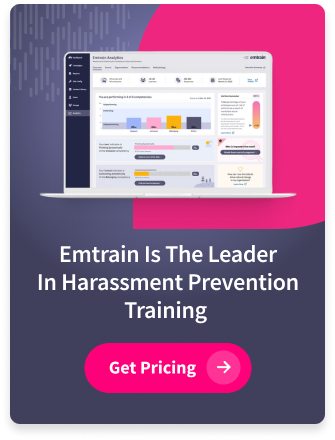Workplace harassment comes in all forms. As large companies like Salesforce commit to full-time work from home schedules, HR and Legal teams need to be vigilant of new forms of disrespectful conduct. It’s important to be aware that the transition to remote work might have been more difficult for some than others, which can have a significant impact on organizational norms and practices. Norms and practices are mutually understood behavioral dynamics that affect how we treat each other, who gets heard in meetings, and decision making processes. With this new working environment, people may be behaving differently and getting a little too casual, which could undermine respect norms. HR teams are responsible for regularly checking in on their employees to understand how work from home (WFH) has affected workplace culture, for better or worse.
Reasons for Remote Workplace Harassment
At a glance, one might assume that the opportunities for harassment decrease when working from home. Though, upon closer inspection, it is the opposite. The remote workplace environment opens up a whole new world of potential remote workplace harassment situations. In June 2016, the Equal Employment Opportunity Commission cited “Isolated Workspaces” as a major organizational risk factor for harassment.
When working from the comfort of our own homes, there is a shift in mindset. Employees become more relaxed, and there is less pressure to dress professionally and thus, act professionally. Within a few months of the first Shelter in Place order, we were all pretty sick of the “I’ve been wearing the same sweatpants all week…” jokes. But this is indicative of the mindset people are adopting: I don’t have to dress professionally, and, in some cases, I don’t have to act it either. A work from home dress code might be unnecessary, but reminding people to comport themselves in the same manner they would at the office is both a reasonable and important request.
 The risk for remote workplace harassment goes beyond some work attire faux pas and oversharing about a quarantine routine. People are isolated, working in their own bubbles without the watchful eyes of coworkers nearby. Some employees might, even unknowingly, respond to this situation by acting on feelings they would not normally acknowledge. For example, making an inappropriate remark about a female coworker’s top on a 1:1 video call, a racial innuendo in an instant message, or even an offensive photo in an email. Whether it is a result of isolation fatigue, stress from working in a family setting, or just bad actors capitalizing on the situation, some of these things are bound to happen. Knowing that a bystander won’t be able to step in may spur bad actors forward, but harassment laws still apply whether or not we are working in person.
The risk for remote workplace harassment goes beyond some work attire faux pas and oversharing about a quarantine routine. People are isolated, working in their own bubbles without the watchful eyes of coworkers nearby. Some employees might, even unknowingly, respond to this situation by acting on feelings they would not normally acknowledge. For example, making an inappropriate remark about a female coworker’s top on a 1:1 video call, a racial innuendo in an instant message, or even an offensive photo in an email. Whether it is a result of isolation fatigue, stress from working in a family setting, or just bad actors capitalizing on the situation, some of these things are bound to happen. Knowing that a bystander won’t be able to step in may spur bad actors forward, but harassment laws still apply whether or not we are working in person.
Staying Vigilant
How can HR teams put safeguards in place to prevent or spot remote harassment situations in this workplace environment? It comes down to driving home the importance of cultural norms and practices. While it may be a big ask to request that employees dress in everyday work attire, it is reasonable to expect employees to dress as they would if they were going out in public. While wearing gym clothes or sweat pants doesn’t inherently constitute harassment, they lead to people letting their guard down, oversharing, or failing to act respectfully.
Ensure that employees know how to report a harassment situation! The EEOC’s guidance on isolated workplaces specifically states that employees in isolated situations are more vulnerable to harassment and “Harassers have easy access to such individuals, and there generally are no witnesses to the harassment.” While this issue is difficult to amend in remote work environments, there are options.
Here are 4 ways to prevent remote workplace harassment:
- Ensure that employees are aware of any and all harassment reporting methods they have at their disposal.
- Set up hotlines and anonymous reporting channels, so employees feel comfortable calling out remote workplace harassment without fear of retaliation.
- Regularly check in with your workforce and remind them of these methods.
- Encourage workers to loop colleagues in on meetings if they are not comfortable in a 1:1 setting with certain individuals. While this is not a permanent solution to cutting out bad actors, another pair of eyes and ears will likely mitigate further severe or pervasive conduct coming from the harasser.
While training on workplace harassment is an annual or biennial requirement for employers in most states, HR and L&D teams can conduct additional microlearning trainings on specific topics to remote work. Emtrain has lessons for video conferencing conduct, instant message etiquette, and a suite of other microlessons. Microlearning is a valuable addition to a compliance training program because it can hone in on more niche topics than a broader training, while reinforcing general workplace culture best practices.
Addressing these issues from a workplace culture standpoint is a great way to develop healthy organizational norms and practices; but as we are fundamentally changing the way we work, it is crucial to remind employees of specific harassment policies and take a hardline stance against inappropriate behavior. Revise your harassment prevention policy to reflect new instances in which remote workplace harassment might pop up, and communicate what exactly constitutes harassment. According to the United States EEOC…
“Harassment is unwelcome conduct that is based on race, color, religion, sex (including pregnancy), national origin, age (40 or older), disability or genetic information. Harassment becomes unlawful where 1) enduring the offensive conduct becomes a condition of continued employment, or 2) the conduct is severe or pervasive enough to create a work environment that a reasonable person would consider intimidating, hostile, or abusive.”
No part of this definition is specific or limited to in-person exchanges.
The employee experience goes far beyond the confines of an office space. Employers need to remain vigilant of new harassment situations, especially for HR, Legal, and People Ops teams. For more guidance on sexual harassment prevention, demo Emtrain’s new Preventing Workplace Harassment Training Course, updated in 2021.








